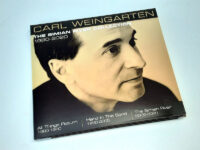by Nick DeRiso
Like “alternative” before it, the term new-age music has been stretched out of shape by the varied and interesting voices that have gotten involved over the years. But you’ve got to have a label for the bins at those mall record stores. And, so it goes.
Peek inside, though, and you’ll find several different layers. Take Christopher Caouette, a Connecticut native who performs lush, yet amped-up instrumentals. Rather than the aired-out space music you might expect, he’s more into a rich tapestry of song, often multi-layered, that brings in influences from progressive electronic fields and classical composing.
“It’s very epic sounding,” Caouette says of his work, “like a soundtrackish type of music, if ‘soundtrackish’ is a word. It’s classically influenced, but using synthesizers.” That’s because Caouette was classically trained for many years, even while he got interested in electronic music. So, those elements are mixed in there: baroque counterpoint and strong rhythm — something that almost sounds like (here we go again) world music.
This album, a tribute to Caouette’s love of dragons, is part of an enormous opus of self-produced work. “‘Ring of Dragons’ is probably number 40,” Caouette tells me, and laughs. “It takes a lot longer than it did in the old days,” he adds — because of the technological advances in the studio and because he writes differently now. “The early stuff was very unstructured,” Caouette says. “And I have a lot more equipment.” On “Ring of Dragons” and elsewhere, Caouette isn’t afraid to let a song spool out. “I do have some smaller pieces. For me, a five-minute piece would be short,” he says. “Typically, the way my albums work is there will be at least one long piece with several movements and a lot of shorter pieces — the longer pieces being 12- to 15-minutes long.”
Yet, even with a longer composition, Caouette keeps the song front and center. He’s not noodling. “My primary goal has always been: It’s gotta have melody. I like Tangerine Dream, for instance, but their melodies are not very lyrical,” Caouette says. “If you wanted to compare my to anyone, it would be Kitaro. But even my lighter pieces seem to have a power chord.”
Caouette still vividly remembers the first new-age record he heard, back in the mid-1980s. “At that point, I had been trained on a piano for about 10 years. I was still living with my parents,” he says. “I heard that my sister had bought the ‘Cosmos’ soundtrack — you know, with Carl Sagan. That had some classical music, but also had Vangelis.” The pianist quickly discovered a desire to say bye to Bach: “That’s what got me started,” he says. “From there, I heard Tangerine Dream and Kitaro (a clear influence). This was the sound I wanted to do.”
The evolution wasn’t as jarring as it might sound, either. “I was always kind of an improvisational composer when I was strictly playing piano,” Caouette says.
Since getting into electronic instrumental music, he’s expanded his palette to include multiple keyboards, guitar, a variety of wind instruments and percussion. And because he was already writing, Caouette says important early influences like Synergy have become more like footnotes in his sound. “Nowadays, these are some of the big guns of the new-age movement — and I still consider them the best writers.”
With “Ring of Dragons,” Caouette showed he was ready to join them.
[amazon_enhanced asin=”B001A3A8Y4″ price=”All” background_color=”FFFFFF” link_color=”000000″ text_color=”0000FF” /]
- How Deep Cuts on ‘Music From Big Pink’ Underscore the Band’s Triumph - July 31, 2023
- How ‘Islands’ Signaled the Sad End of the Band’s Five-Man Edition - March 15, 2022
- The Band’s ‘Christmas Must Be Tonight’ Remains an Unjustly Overlooked Holiday Classic - December 25, 2016




